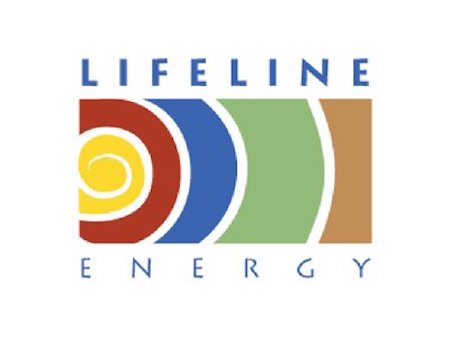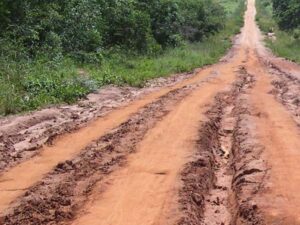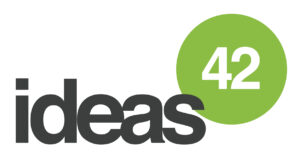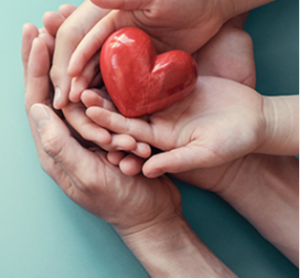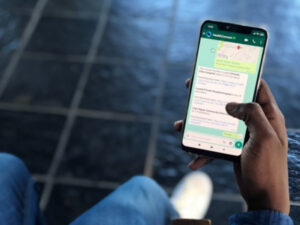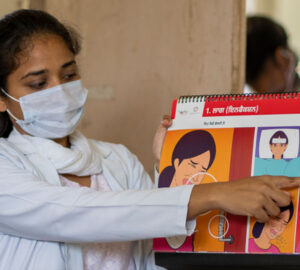Lifeline Energy creates and distributes solar and wind-up MP3 players and radios to increase access to information and educational resources in sub-Saharan Africa.
Kristine Pearson of Lifeline Energy spoke with Erica Edwards on April 12, 2023. Click here to read the full conversation with insights highlighted.
Erica Edwards: Can you start by introducing yourself, your role in your organization, and the problem your work addresses?
Kristine Pearson: My name is Christine Pearson. I’m the founder and the CEO of a US and South African nonprofit called Lifeline Energy. We’ve been around going on 25 years now. We seek to address access to information for the most vulnerable, mainly in Africa, or people in situations of conflict or natural disaster that don’t have access to information. Our channel is via radio or MP3 as opposed to an app or a phone. We design, manufacture and distribute the actual hardware and then work with the content provider to ensure their content is heard.
Erica Edwards: What sparked your interest in addressing this issue?
Kristine Pearson: Initially, I was minding my own business. I was an executive of a banking group in South Africa, and my husband started a company that created the first original windup radio, and I was on sabbatical for the bank. I was asked if I was interested in getting a non-profit arm going and my first response was, no, I’m not interested in non-profit. I wasn’t comfortable with the non-profit sector as I hadn’t seen it or understood it. Then I took an original model windup radio, if you can imagine this, it was huge, it had a crank on the side that wound in one direction. I took it into rural Mozambique where I knew someone who could take me into an area where there was no presence of technology other than a radio in a bar or something like that.
That was a genuine Rubicon moment for me because as I sat there with an interpreter and talked to these women and asked them questions, they thought I was nuts. They looked at me like, why are you here? I was asking things like, what do you listen to on the radio? What are your favorite programs? What do you learn? How often do you buy batteries? I had all these questions and they just looked at me blankly because whatever radio programming they had access to wasn’t in a language they understood. They didn’t have money for batteries, they didn’t have a radio at home. If there happened to be a radio, it was at the bar and you could go and listen collectively and generally in Portuguese, which they didn’t speak, but radios were for men. One woman said, well, her husband had a radio, but if she touched it, he’d beat her. It was a real gender issue. And the penny dropped for me because, at that time, it was hard to imagine you couldn’t get information.
If you’re starting something, what’s the first thing you do? You research it. You’d want to know who’s listening, what kind of programs, how often people buy batteries and how much of their monthly spend do they spend on them, who controls listening. The basic questions that I think anybody would ask didn’t exist because there weren’t radios, so what the VOA and the BBC did at the time, it’s not the same now, but if you listened to a program once a month, you were considered a listener. You might have listened to that program at the bar or a bus stop or something if there was a radio, but you were classified as a listener, and those big content providers didn’t get funding unless they had listenership. The statistics were ridiculous.
Then it occurred to me that if you could get information to people, you could start to change outcomes. If you could get information to women, they could make important decisions in their life other than by guesswork. So one day I wasn’t interested and the next day I was a zealot. I did a lot of research on my own. I’m a trained process facilitation consultant, so I conducted interviews and the process was very comfortable and easy for me. I had the most incredible journey.
This was the late ’90s and into the early 2000s when AIDS was ravaging sub-Saharan Africa, and there was no way to reach people other than radio. None. Unless you physically went to them, which wasn’t always easy. It was also post-genocide Rwanda, which wasn’t just Rwanda. It really impacted all of Central Africa and parts of East Africa as well. You had an influx of refugees not seen since the second World War, and without access to information, of course, the majority of refugees are women and children. You had schooling interrupted. AIDS was killing two teachers for everyone that was trained in Southern Africa, Zambia in particular. You started getting radio programs addressing health issues and addressing education as never before.
But who could afford to buy batteries? We had a group listening product that could be used, but I realized that this radio was inappropriate for people in rural areas because if you wound it anti-clockwise, it would break. I spent a lot of time in post-genocide Rwanda, I am not qualified to have been there, I had no way to deal with what I saw. It’s indescribable, the collective trauma and the destitution. There were 101,000 households headed by a child. You had nine year olds heading households with only the clothes on their back.
It was a long story about how some radios, a thousand radios, ended up there. The British government bought them for the people living in the hills in Croatia during the post-Balkan war, but they didn’t take them so they just sort of put them into Rwanda. A charity started distributing them and then contacted me saying, “These radios are making a huge difference to child-headed families. Can we get more?” What was the child-headed household? I didn’t know what that was, so I went and I saw that these children were so dependent on radio because they didn’t have adults they could trust, or they didn’t have adults at all. So the voices on the radio were the ones they trusted.
Erica Edwards: Can you tell me when you started this organization and how many radios you distributed?
Kristine Pearson: It was officially started in January of 1999 with about 705 radios, or something like that. Now, with group listening radios, one radio could impact 100 people. That’s not unusual, especially in classes, with one class after the other using the radios. Individual or family size radios will go for anywhere from five to 10 people. So a lot of people were impacted.
Erica Edwards: Can you give me an idea of the magnitude of impact your radios have had on the population?
Kristine Pearson: Oh, they’ve impacted 20 million people or more, 25 million. We don’t actually know. We can’t actually find all of them because they go into deep rural areas. I have seen these radios still to this day. Two months ago I was in Rwanda, I’d gone with an NGO that had invited me to go with them into the field, to an area in Rwanda in the north that I had worked in 10, 12, 14 years ago. I said, “Have any of you by any chance ever seen these big blue radios?” And they all raised their hands. I said what? This was from 2008 or 2009. They said, “Yes, we still have them.” That was amazing to me. What I’ve left out is this radio was unidirectional, it would break if you wound it anti-clockwise.
I was determined that we would have a radio that would be created for distance education and for children living on their own. I took this to all the big agencies I could think of, I don’t want to name the names, but all the big NGOs. I went to them because that made the most sense to me. I needed a quarter of a million dollars to bring this product to market. It really did cost that much. And I got nowhere. Every door closed, “We don’t do technology”, “We wouldn’t fund something like that,” “Children shouldn’t have radios.” I got all kinds of excuses.
Then a friend sent me a note that said, you should put your radio idea to this Tech Museum of Innovation Award, and the deadline was that day. This was in California, in Silicon Valley, and I contacted them and said, “I’ve just seen this. I really want to enter this award. Can I have 24 hours to get you a proposal?” My PA and I stayed up all night and got it done. And we won. There were 63 finalists and we were the unanimous winner. The idea was to create a radio whose design brief would come from the end user. I’m a dress designer. I started sewing when I was young. When you sew, and if you’re making something for someone else, you design from their perspective.
I felt we had to design from the perspective of the people who were going to use this, even though they weren’t going to buy it. I collected and created design briefs based on orphan children or kids who had no exposure to technology. In the end, we got $50,000 from them, and then I got the balance from a couple of tech pioneers, Vodafone and Anglo-American, and I got my $250,000. A year later I had a radio.
Erica Edwards: What insights or teachable lessons can be taken from your work that you think others can use?
Kristine Pearson: It depends on the perspective, how small you are, how big you are, what your competition is. It’s a really broad question. I’ve worked extensively with big NGOs, international NGOs. If you work in America, international development is very different from what you would do if you’re serving an American population or a European population versus the Pan-African league. I’ve been to 35 African countries, so it’s a very broad spectrum of cultures and communities. You have to know who you’re serving. Africans don’t need people from elsewhere coming in. They just simply don’t. I tell my interns that Africa doesn’t need you. I have an American accent. That’s where I grew up, but I’ve lived in South Africa most of my life. If you really want to make an impact, if you really want to make a difference, you let those you’re trying to serve be your guide, be your teacher. You listen to them and try to determine how you can best add value.
We had a technology and a product people really wanted, and still do want, although donors don’t see it the same. They think that cell phones and apps are better answers, but apps don’t speak to you in your own language. There are tens of millions, if not hundreds of millions, of women especially who don’t speak anything other than their mother tongue, which is a local language. There are no programs, no apps in their language, but there’ll be radio programs, someone speaking to them in their language.
You have to work out the best way that you can be. Take your skills and talent and network and funding resources, whatever you have, and find out how you can best serve the communities that you’ve committed yourself to. As opposed to, we’ve got this great solution, this is what we’re going to do. You have to really understand and try to get to know those you’re serving, build trust and friendship. I had to really trial and error from scratch. An earlier mentor of mine from Skoll, Mohammed Boulahya, Africa’s chief meteorologist for many years, is the one who really taught me about community-based solutions and listening to communities. Do not even think about doing anything until you’ve understood a little bit about that culture’s background, what their family dynamics are, what a woman’s day is like, what a man’s day might be like, and so forth
We had an amazing guns for radios program. There had been a conflict between rival tribes and the French had gotten involved. It was very destabilizing in the area. We created a program where you could turn in your illicit small arms for a radio that didn’t need power.
Erica Edwards How many guns would you say were collected?
Kristine Pearson: We had 12,500 radios, so how many guns? I’m not actually sure, because some people might have turned in two. We did that in collaboration with the UN and the military in Niger. That was a great project with the local sultan.
Erica Edwards: How do you measure success, Christine? What is the evidence that you’re making progress?
Kristine Pearson: I measure success with feedback. Feedback from the people who say, “This is what I learned, this is the difference the radio made to me.” I don’t ask the questions you’d get on a USAID form. I want to know how this radio’s helped you from a psychosocial basis, what new information have you learned? How is it helpful or wasn’t it helpful? These are power independent, they’re solar and they’re wind-up, so people don’t need to buy batteries. They’re either distributed to groups where the whole group uses them or they are distributed to individual families in a disaster situation.
Right now, for example, we have a radio program with the Kenya Broadcasting Corporation in Kenya to provide radios, menstrual hygiene products and education to girls who stay at home because of their periods. That’s a major reason why rural girls stay at home. If they can get the school lessons while at home on the radio, it helps them stay informed, it helps them keep up. People tell us they can’t imagine their life, what it would’ve been like not to have had the radio.
We look at what people say the difference having that access made. There are so many examples of that. You can look at whether donors keep funding the same projects, or if big NGOs keep buying the radios. Do you have a lot of repeat customers? I don’t really look at it like that. I obviously want radios to continue to go into projects or initiatives, and those are really helpful to have. For me, it’s what people say and how they speak of this radio as their friend and the psychosocial support that it provides.
Erica Edwards: Every social change model has strengths and limitations. What do you see as the main limitations of your work?
Kristine Pearson: For scale, it’s dependency on large institutional organizations. That could be the UN or big NGOs, and I find them almost too difficult to work with because they’re not collaborative, they’re not cooperative in the same way that a smaller organization would be. They’re very top down. They will see you as a supplier because they’ll know how to do this or they’ll know how to do that. They don’t spend enough emphasis on training, and anytime you introduce technology, you have to have training around it, even if you know how to operate it. How are you going to share it? Who’s going to be responsible for it? What are you going to do if it breaks down? As an organization, if we had emphasized the training aspect more, that would’ve helped because we just sort of assumed people would do it.
Erica Edwards: Was that earlier on, or is that your general experience working with the NGOs?
Kristine Pearson: With big NGOs, especially on larger projects, it’s a real barrier depending on how much tax is levied on the products. If NGOs buy them from us, if they want to sell them or if they want to lease them, we don’t care. But we’re not interested in selling to a company. We will only work with those who have a humanitarian purpose. Maybe that was a limitation of the model as well. We had a for-profit arm, which we just closed, where any radio sales profits would come back to the charity.
Erica Edwards: Why did you close that?
Kristine Pearson: It wasn’t profitable. It was based in the UK, and the UK has a lot of rules. You have to audit, it’s expensive, you have to raise a certain amount of funds every year just to have a charity in the UK, so we had to close down our office here. I think that because I see the value that radio brings to people, I underestimated the impact other technologies would have on the donor sector who would be turning to apps. Even though most apps fail because they’re not created in collaboration with the people who are going to use them. There’s an elephant graveyard of well-meaning apps across Africa. In hindsight, I would’ve done a lot of things differently.
I would have been much more assertive on the benefits of radio and campaigned for that. I would have been much more assertive in reaching out to organizations that could have reached others through our products, but I was always really sensitive not to come across commercially. For a long time our phone rang off the wall. We were in the media because we were the first and only ones doing what we were doing. I would have also had a base in America. We’ve always been legally registered there, but we never had an office there. I would’ve had a fundraising office in Washington. There’s just a whole lot of different things that I see could have leveraged us better, but the sector now is a different sector than it was 10 or 15 years ago.
Erica Edwards: How so?
Kristine Pearson: I see it becoming more collaborative. I see issues like systems change actually being discussed. I see what I would call a true partnership, which I never really saw. Big NGOs would see us as a supplier unless we raised the money, which we often did, and then we’d pick our partners and we could control the process much better. If we were to pick a local NGO, and they really wanted our products, we’d have to say, “These are the terms and conditions under which we’ll donate them to you. We’ll do training. We’ll be there and do monitoring. We need you to do the evaluation or to help with the evaluation to see what the impact is.” If they didn’t have a line item in their budget, if we weren’t paying for it, they weren’t going to do it. They’d say they didn’t have any budget left to do any monitoring.
Erica Edwards: How are you catalyzing change in your field?
Kristine Pearson: I think access to information by radio is extremely powerful. We’ve added an MP3 feature which enables you to pre-record programming if you’re in an area that doesn’t have a good signal or if it’s a specific issue that you’re addressing, whether it’s education, a health issue, governance, or whatever it might be. We do a lot of facilitation work with local communities on what it’s like to be a facilitator and how you allow everybody’s voices to be heard.
I’ve been very involved in something called Catalyst 2030, I’m a founding member. I’ve started a side hustle called Lisa Communications and through that, and the reach that it has, we share a lot of messages around systems change, around social innovation, around systems thinking, all these ways to approach problems.
I’m not controlling the narrative, I’m giving the narrative voice, and I think in a very professional way. It’s creating its own sort of butterfly tsunami of people looking at their own work differently and starting to see examples and role models of collaboration. All of these NGOs, the government and other stakeholders are addressing part of the problem somewhere along that chain. When everyone comes together to address the whole chain, and sees that everybody benefits and everybody wins from that approach, you’re much more likely to get a different outcome.
My work in communications, in radio, has been of great benefit to crafting messaging for the websites we create, the ghost-writing we might do, the editing we might do to shape narrative in what I think is quite a positive and inclusive way. I’m also always there, particularly in rural areas, promoting women and their voices, getting their voices on the radio and helping to provide learning resources for rural women that are all audio.
Erica Edwards: What do you think is needed from other stakeholders to foster change?
Kristine Pearson: Donors need to fund differently, think differently. There’s a big movement within Catalyst right now called Shifting the Narrative, and I wholly support that. When Catalyst started, which is now almost four years ago, my opinion was it would never work because social entrepreneurs from my experience, were not collaborative with one another. They were highly competitive with one another, and that’s because of the way donors fund. They weren’t doing anything that to say, you need to be collaborating with this person and if you collaborate with them and them and them, we’ll have a better outcome. They would say, “We’ll give you the funds. This is what we want you to do with them. This is the kind of variation you can or can’t have from those funds. This is how often we want you to report.” It was very much power over as opposed to looking at grantees as partners in solving a problem. There’s all kinds of shifting going on because of the problems we’re facing, whether it’s climate change or democracy, can’t be solved in isolation. They have to be solved collectively by a wide range of groups and I think there’s a slow awakening to this.
Erica Edwards: How do you see your work evolving over the next five years?
Kristine Pearson: I see radio coming to a natural end in a way, or at least our aspect of it from a product point of view. I’m working with a very well-known organization who’s working with technologists who’ve invented a new radio technology that will have the power of shortwave at very low cost and very high clarity of FM. This will be a renaissance for radio because it will enable nomadic groups, people that live in isolated areas, to have ongoing access to information, which they really struggle with now. Millions of people still struggle for information because it has to be in a language they understand.
Erica Edwards: As the technology of radio started reaching and being present in more communities, I’m imagining there was an adjustment for content providers to create content in said communities’ languages? Did that generate more investment in these communities so that people can have access?
Kristine Pearson: What has happened is the proliferation of community radio, radio that is based in your community. The BBC and a lot of inter news organizations have worked on capacity building journalists at the community level. That’s where women are trained as journalists, as announcers, as producers, and women want to hear women’s voices, the grandmother’s voice.
Every country is different because every country has radio license laws for community as well as commercial radios, what you can and can’t put on the air. There has been commercial investment by governments and commercial investments by companies, it’s paid for in advertising revenue ultimately. But community radios struggle because you can’t have commercial support and you can’t be political, so they have to depend on communities, NGOs or donations for support. The power of radio is no less, but what I see is the investment is going into an app, it’s going into cell phones.
It’s not that I’m anti-phone. There’s no one technology that’s the answer for us, and it’s no different for people who are in rural areas and are very poor. Everybody wants information, but everybody isn’t starved for entertainment in the same way. They don’t look for entertainment in quite the same way. I get all the time, “People can just listen to the radio on their cell phones.” Well, yeah, sometimes they can. It depends on how good the signal is and it also depends on if they have data, which costs money. Whereas just a regular radio transmission doesn’t cost money.
However you can get information, especially to rural women and to kids, is useful. Radio is just an extremely viable channel. I explain to people in America and South Africa where I live, if you’re affluent, you’re listening to podcasts, how’s that any different? Podcasts are big, so think of these as rural podcasts, a program on maternal health or a program on Guinea worm or voting or anything.
Erica Edwards: Is there anything we didn’t cover that you feel is important to add?
Kristine Pearson: I don’t think you can underestimate the power and impact it can have when women get together, especially of a woman’s listening group, and listen to a maternal health program and discuss it. They are able to make informed choices about themselves and their families, and I have so many examples of how a radio program, and a way to listen to it, has made a difference in people’s lives.
Erica Edwards: What’s the most memorable example of that impact that you cherish?
Kristine Pearson: There are so many. I’ll give you two. One was from Ford Ward, who was a 14-year-old Rwandan orphan head of household. He became a listening group leader, this was a big radio for a lot of kids in his area. He was responsible for the radio and bringing the other children in to listen. Another NGO gave him a cow and when I asked which he would rather have, the cow or the radio, if he could only have one, he said, “I pick my radio. A cow doesn’t give me information.”
Another example was Lucy, an eight-year-old Zambian girl who is an orphan. Due to the dire teacher situation created by AIDS in Southern Africa, the Zambian government put their entire primary school curriculum on air. This was initially a USAID funded project. I was chatting with some of the children who were part of a radio school program, and the teacher was Mrs. Musanda. I asked Lucy if she liked radio school and she said, “Yes.” I asked why and she said, “Because Mrs. Musanda loves me.” That’s the radio teacher. When I asked how she knew the teacher loved her she said, “It’s the way she speaks to me.” I said, “Okay, do you know what Mrs. Musanda looks like?” She said, “Yes.” And she described a traditional grandmotherly woman who was always smiling. That was Lucy’s imagination.
When I asked the other kids if they liked radio school they said yes, they love learning this way. I asked everyone separately what Mrs. Musanda looked like and they didn’t hesitate. She looked different to almost everybody because that’s the power of imagination. Nobody was right and nobody was wrong.
I also saw in Zambia, which has the fifth highest rated stenting in the world, there was a women’s health program with the Food Nutrition Commission. Mothers were giving their children water and not breastfeeding because that’s what their grannys said you did. Children were dying because they weren’t being breastfed. The radio program treats you with respect and it has a nurse who’s talking to a grandmother, so you’re getting the local voice and it’s conversational. It’s not threatening. I used to think that I had to give my baby water, but now I understand why my breast milk is so important, and also why I need to take folic acid.
Erica Edwards: I know your organization produces and distributes the radios. Can you describe your relationships with content providers?
Kristine Pearson: We try to have a relationship with the main content provider. There may be one or there may not be one, but in the Zambia example, that was the government. It produced a two-part series of programs. We do the training with the radio and then somebody from the ministry would be side by side with me saying, “There’s going to be 20 episodes. This is what you can expect and this is why you need to be sure that you’re there every week. If you miss it, you can use the MP3 to come and listen later, but make sure that you don’t miss the program because you need to listen to each one to hear how you can do the very best for your baby for the first five years of life.” The radio program was produced in eight languages, including English. That’s why I could understand it. It’s wonderful and so rewarding when you see people that are learning and listening. It’s been a great ride.
Erica Edwards: It’s been such a pleasure talking to you and hearing about the impact of your work.
Kristine Pearson of Lifeline Energy spoke with Erica Edwards on April 12, 2023. Click here to read the full conversation with insights highlighted.
Erica J. Edwards is a multimedia journalist based in NYC. She has worked at New York Public Radio, WTAE, WMUR, and the Mayor’s Office of Media and Entertainment (MOME). Edwards was a LEDE Fellow within the Solutions Journalism Network. She is deeply passionate about bringing solutions journalism to the forefront of the public’s news diet through social media.
* This interview has been edited and condensed.
Find other organizations increasing access to educational resources.

